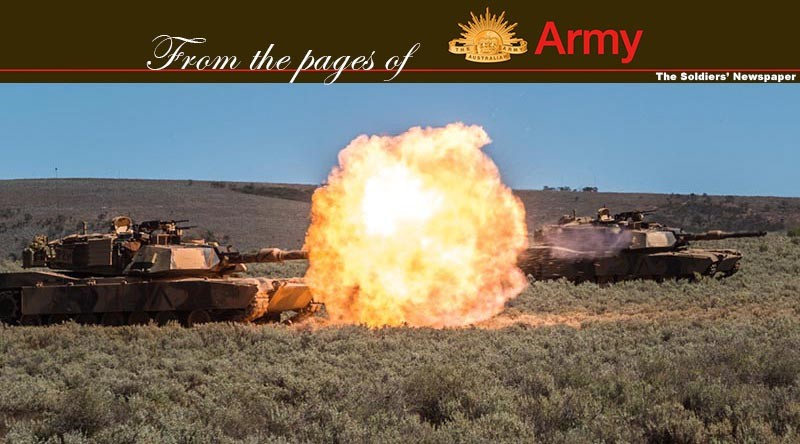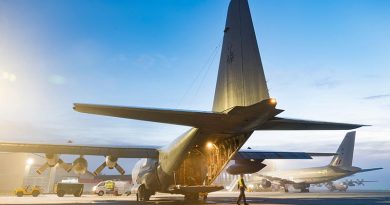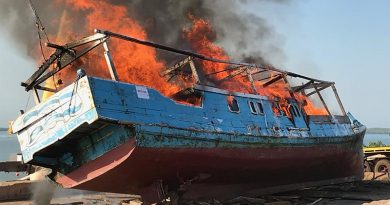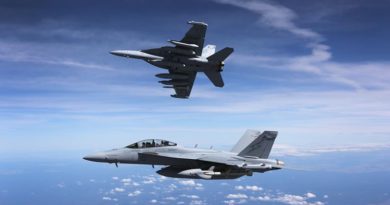1 Bde on the road to ready

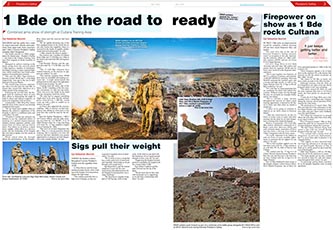
Combined arms show of strength at Cultana
By Cpl Sebastian Beurich
Photos by Cpl Nunu Campos and Sgt Janine Fabre
SOLDIERS and the public have come to expect armoured vehicles and explosions from large-scale Army exercises, and 1 Bde’s Exercise Predator’s Gallop certainly didn’t disappoint.
The fourth exercise in 1 Bde’s preparation for Hamel plan – Predator’s Gallop – was held at the Cultana Training Area near Port Augusta in South Australia in March.
Designed to achieve training at the battle group level, the exercise pitted 1 Bde against a number of challenges, including crossing a major regional highway, which would have real world consequences if not performed correctly. This year two BGs, Tiger and Lion, formed around 5RAR and 1 Armd Regt respectively, were put to the test in their lead up to Exercise Hamel.
The month-long exercise culminated with a live-fire lane for each BG, in which they seized four objectives in a 10km stretch of the training area.
Following the live-fire lane, the brigade held its traditional show of joint fires effects to demonstrate the might of both its direct and indirect weaponry, as well as its integration with Air Force. Commander 1 Bde Brig Ben James said the focus of the exercise was forming combined arms teams.
“We are much more capable when we harness the collective capabilities of the brigade to deliver a combined arms and joint effect,” he said.
“Predator’s Gallop has allowed our leaders to see the combined efforts of working in a unified manner between infantry, armour, engineers, artillery, joint assets from Air Force and our reserve units. This allows us to deliver a much more capable, lethal effect at a decisive point, and the leadership of the brigade has seen that in spades over the course of the exercise.”
When asked what he thought about the performance of the brigade, Brig James said the exercise had been fantastic.
“We are rapidly becoming one of the best equipped armies in the world, but we can only realise that capability when it’s exercised in the hands of capable, professional and motivated people,” he said. “1 Bde certainly has them in spades.” The exercise saw a number of soldiers from6Bdeand17CSSBdejoin1Bdein the field to provide both ISR and logistics support.
Capt Brendan Thomas said the support provided by 17 CSS Bde was first class.
“The 17 CSS Bde elements have worked tirelessly on the exercise to support our soldiers,” he said. “The catering company from 10FSB have done an incredible job keeping everyone fed – it might sound menial, but getting food on time and in the right place is what keeps us going,” he said. “Coming from the safety side of the house, 8CHC’s handling of the few casualty evacuations we had was top notch. There was never any doubt in my mind that any emergency would be solved. “We only had to suggest something might need to be done and the military police from B Coy, 1 MP Bn, would come up with a plan to enable us to achieve our goal.”
Air Force also supported the exercise, enabling 1 Bde to practise air-land integration and adding an extra facet to the joint fires that could be used by the brigade.
Sqn-Ldr Nathan Thompson, 1 Bde’s Air Liaison Officer, said the radar tracking provided by 114 MCRU, F/A-18 Super Hornets from No. 6 Sqn and King Airs from No. 32 Sqn enabled a higher level of training for 1 Bde. “This level of air-land integration has put 1 Bde in a strong position during readying. We’ve learned a lot from the exercise and have identified even greater opportunities to progress air-land integration in the coming months,” he said.
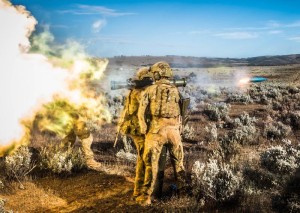
Firepower on show as 1 Bde rocks Cultana
By Cpl Sebastian Beurich
IN TRUE 1 Bde style, no major exercise would be complete without showing off just how much firepower they can muster.
The joint fires day at the end of Exercise Predator’s Gallop certainly wasn’t an exception to the rule, showcasing the collective efforts of 1 Bde’s artillery, mortars, DFSW and two Air Force F/A-18 Super Hornets.
CO 8/12 Regt RAA Lt-Col Rob Alsworth said more than 100 soldiers and airmen from his regiment, 5RAR and Air Force were involved in the firepower demonstration.
“We’ve put together two batteries of M777s, a platoon of mortars, and elements of 5RAR’s DFSW Pl, including .50cal and MAG58 sustained fire machine guns, and a Javelin anti-tank missile, as well as two Super Hornets from No. 6 Sqn at RAAF Base Amberley,” he said.
“It’s vital that we keep practising how we coordinate live direct and indirect fire systems. Without troops moving through the area, we can push our concepts further and try new things.
“We’ve learned a huge amount throughout the exercise. It’s been a great training opportunity, evidenced by the fact we’re better now than when we started a month ago. “I know we’re going to continue to improve as we move closer to Exercise Hamel.”
1 Bde has relied heavily on the Air Force in recent years to assist with their training, but the push for air-land integration is coming from inside the brigade. Battery Commander 102 Coral Bty Maj Andrew McDonell commands 8/12 Regt’s joint fires observers (JFOs) and joint terminal attack controllers (JTACs) and has been a driving force behind 1 Bde’s integration with Air Force assets.
“It’s really important to be linking in with Air Force at every available opportunity to maximise the air support we can achieve,” he said. “We’ve had excellent support over the last three years with No. 4 Sqn coming to us with their PC-9s, both in Darwin and Cultana.
“We worked with No. 77 Sqn F/A-18 Classic Hornets during Exercise Predator’s Run last year and this year is the first time we have worked with No. 6 Sqn F/A-18 Super Hornets.” One of Maj McDonell’s best assets is the brigade airspace control liaison officer, Flt-Lt Martin Ferguson, one of three Air Liaison Cell.
“Flt-Lt Ferguson spends a lot of time down at the regiment. He is the human link between us and the whole air picture at HQ 1 Bde,” he said. “He comes to 102 Bty so much, we have a desk set aside in the office for him.”
Although training with the JFOs at 8/12 Regt RAA isn’t part of his job, Flt-Lt Ferguson finds it to be very rewarding. “The better trained the JFOs are and the more exposure they have to Air Force assets, the more punch we can provide,” he said.
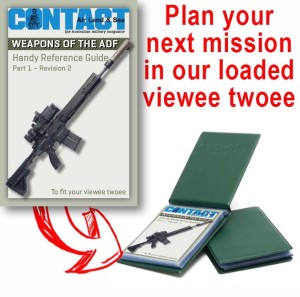 “I took the 8/12 Regt JFOs and a few members from 1 Armd Regt onto a feature during the exercise and we practised JTAC controls for a few hours. “We practised as if I wasn’t there. The JFOs provided all of the information to the two Super Hornets, and I listened in on my own radio and gave them some feedback once they had finished.
“I took the 8/12 Regt JFOs and a few members from 1 Armd Regt onto a feature during the exercise and we practised JTAC controls for a few hours. “We practised as if I wasn’t there. The JFOs provided all of the information to the two Super Hornets, and I listened in on my own radio and gave them some feedback once they had finished.
“8/12 Regt has trained me in ground effects far more then what I have been able to give back to them.” Flt-Lt Ferguson joined 1 Bde as they started the push for an increased level of air-land integration during their exercises.
“We had Classic Hornets flying four sorties a day with two aircraft during Predator’s Run last year,” he said. “I’ve worked with a similar level of integration on previous deployments, but I’ve never been able to practise it in Australia before.
“The support we have received from Air Force has allowed us to develop into an air-land brigade. Because of that, I think we’re setting ourselves up to lead the rest of the brigades.”
LBdr Sean Bradow, a JFO in 102 Bty, loves his job for the memories it creates. “Not many people can say they control live aircraft to drop live and inert munitions throughout their career,” he said.
“It just keeps getting better and better as the brigade integrates more air-land operations.”
Sigs pull their weight
By Cpl Sebastian Beurich
AMONG the hardest workers throughout Exercise Predator’s Gallop were the signallers from 1CSR.
Lt Peter Harvey said his troop maintained high morale while working at the brigade forward position, despite the high tempo. “Our soldiers generally have a high level of fatigue, as they are required to regularly move at short notice,” he said.
“We’re lucky to have a troop that has a really great level of teamwork and mateship, which helps us all get through some tough times.”
Sgt Shaun Davis said the limited manpower to provide the communications and administration for the brigade forward position was a major challenge.
“We function as a regular troop, part of 104 Sig Sqn, while in barracks. In the field we just deal with the limitations of our regular posted strength as they come up,” he said.
“Supporting the brigade forward position is probably the toughest job for a troop within 1CSR.” Sig Callum Craddock said brigade forward was the tip of the spear.
“We get more face-to face time with the people we’re supporting, so we develop a relationship with them,” he said.
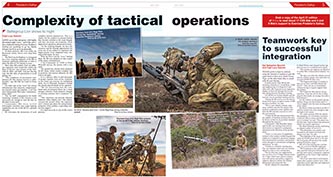
Complexity of tactical operations
Battlegroup Lion shows its might
By Capt Lucy Saaroni
LIONS see in blue and green, with highly developed night vision – and if the activities conducted during Exercise Predator’s Gallop are anything to go by, Battle Group Lion lives up to its namesake. In thick darkness, BG Lion stalks the Kamarian enemy forces over deep blue waters.
The Port Lincoln Highway is reimagined as a river, requiring engineers of the BG to construct significant earthworks in order to allow the fleet of 170 vehicles to cross. More than 400 soldiers from six different regiments tuck trojan-like within the fleet of M1A1s and variants of the AS4, ASLAV, PMV and M88. And just like big cats, this BG takes all precautions to avoid getting wet.
“The complexity of movements coordination for this tactical exercise is unbelievable,” says BG HQ Tp Comd Lt Owen Gibbs.
On either side of the “river” lies critical infrastructure that cannot be compromised: an exposed major gas pipeline, a rail line and underground fibre-optic communications cables.
The “no duff” consequences for South Australian residents if this mission is not successful are enough to raise the hair on the back of your neck.
Commander BG Lion Lt-Col Christopher Gardiner says night fighting capabilities are one of the M1A1’s greatest strengths.
He welcomes the dynamism of such complex tactical manoeuvres. This is a chance for his soldiers to practise before they become certified as the ready brigade and face uncertain environments while deployed on operations abroad and at home. “As the readying brigade, we have the resources and the training opportunities for every one of our soldiers to experience the bigger picture of an integrated army, running at full steam,” he says. With the Port Lincoln “river” behind them, the BG now prepares to take control of the enemy command post. 2 Tp Commander at 1CER Lt Peter Witcomb surveys the terrain with a wry smile.
The ground has already been prepared by BG Jacka, which created company dug in positions and tactical obstacles for BG Lion to navigate.
It is a massive effort to pull thousands of people together from across Australia, so the Army can exercise its warfighting skills. For Lt Witcomb, Predator’s Gallop has already paid dividends for his regiment. “We are discovering how the combined team environment allows for a much stronger collective. Each element’s strength is covering someone else’s weakness,” he says.
“Our engineers can provide obstacle reduction where infantry can’t. Our infantry can provide assault where the engineers can’t. Armour uses direct fire and personnel protection while artillery is providing indirect fire support.”
It is hard not to be in awe of BGLion’s prowess.
Teamwork key to successful integration
Cpl Sebastian Beurich and Capt Lucy Saaroni
TIGERS prefer to hunt by ambush, using the element of surprise to gain the upper hand on their prey. Battle Group Tiger, on the other hand, likes to attack with all guns blazing.
Formed mainly from 5RAR and including elements of 1 Armd Regt, 1CER and supported by 8/12 Regt RAA and other units, BG Tiger put on an impressive display on their run through the live-fire lane during Exercise Predator’s Gallop.
CO 5RAR Lt-Col Paul Shields said the exercise was an excellent training activity. “Seeing the BG evolve over the last six weeks from teams of eight to teams of 800 has been excellent,” he said.
“We’ve seen infantry, armour, engineers, artillery and also the logistic and medical components come together and form the BG and then exercise in a livefire environment.
“I think the BG has demonstrated they are capable of handling anything that may be thrown at them to an excellent standard throughout the exercise.”
Commander 1 Bde Brig Ben James said the BG was training to be held on short-notice to respond to contingency operations at the direction of the government.
“There is a vast array of capabilities resident in the modern combat brigade that enable us to respond to operations ranging from humanitarian assistance and disaster relief, through to conventional warfighting operations,” he said.
“Cultana is a fantastic training area. The vast expansive land suits our training objectives and we love coming here.”
The live-fire lane was supported by two Air Force F/A-18 Super Hornets from No. 6 Sqn, which were used in conjunction with mortar and artillery support to suppress objectives before the infantry dismounted and joined the fray.
5RAR’s Mortar Pl Commander mortar support was key to a combined arms attack. “The mortars can suppress an objective to within 90m of dismounted infantry,” he said.
“We take over when the infantry moves into the artillery danger zone and when we are done DFSW Pl takes over.
“The biggest advantage of mortars is they are an asset controlled directly by the CO – they can use us immediately without having to request support from the artillery. “We’ll plan for 5km, but we can go anywhere.
From the call for fire to dropping the first bomb, we average two and a half minutes.” For the soldiers on the ground, having artillery firing over their heads and F/A18s in support were the most exciting parts of the attack.
Pte Riley Collins travelled in an M113 until his section was close enough to take the fight to the enemy. “It’s really exciting. With the adrenaline pumping, it’s over before you know it and you start to realise just how hard you’ve worked,” he said.
“The attack was the first time I had worked with armoured, which was a great experience.” Pte Shaun Dunning said he rated being an infantry soldier 10 out of 10. “The job pushes you, pushes your boundaries and makes you learn new things every day,” he said.
“The highlight of the attack was definitely the bombs [from the F/A-18s and M1A1s] going off and all of the rounds getting fired down range.” But all of this training has a serious side, too, as Lt-Col Shields explained.
“We’ll stand up as the ready BG in July, and from that point forward we will provide short-notice contingency response capabilities as the Army’s high readiness BG,” he said.
“All of our teams had to work hard to ensure their weapon systems were in the right place at the right time and employed safely and effectively.”
.
.
.
.
.
.

.
.

.

